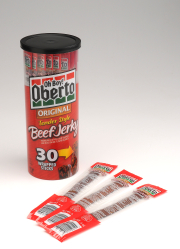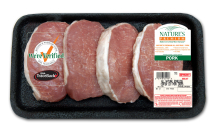PMMI announces last week for nominations
FDA: Irradiated food must bear label
Grocery chain to launch recycling program
Jerky sticks in formed PP canister
System stores pork chops’ DNA

by Pan Demetrakakes
Executive Editor
Major food processors are raising prices to cope with rising costs for ingredients, energy and other expenses, with varying degrees of success.
The U.S. Department of Agriculture recently forecast an increase in food prices of 5% to 6% this year, which would be the largest annual increase since 1990. The USDA also predicted a 4% to 5% increase in food prices in 2009, which, if true, will make it the third straight year with an increase of at least 4%.
The increases are occurring in large part because big food companies like Tyson, Kraft, Sara Lee and Kellogg are raising prices to compensate for rising expenses. And in some cases, the companies are having success.
Kraft announced that its revenue for the second quarter of 2008 rose 21% over the same period last year, resulting in an income gain of 3.5%. Much of that revenue gain came as a result of an average price increase of 7% for the company’s products, which resulted in a sales decline of only 1%.
However, other companies are running into problems. Tyson, hit hard by increases in feed costs, posted a 92% loss in income for the quarter, even though revenue was up 3.5%. Most of the income loss was caused by a $44 million operating loss in Tyson’s chicken business.
Part of the problem is that there currently is an oversupply of meat, poultry and other unprocessed or minimally processed foods. That’s one reason why meat, poultry, fish and eggs rose 2.4% in price in June over a year earlier, while cereal and baked goods shot up 10.4%.
“There's no oversupply of Oreos, so the packaged-food companies have been able to offset enough inflation to post profit growth,” Edward Jones analyst Matt Arnold toldThe Wall Street Journal.
Another factor is the weak dollar, which helps companies that do a lot of business outside the U.S. Wrigley, for instance, enjoyed second-quarter gains of 14% in both income and revenue. The company attributed half the gains to advantageous currency exchange rates for foreign sales.
Some companies are trying to cut costs by substituting less expensive ingredients. TheJournalreported that Hershey is substituting vegetable oil for cocoa butter in some of its chocolates, and General Mills is reducing the number of spice and ingredient pouches in its Hamburger Helper prepared meals.
As the pressure to cut costs persists, packaging will come in for its share of attention-and, in some cases, it already has. For instance, the Hamburger Helper reformulation also led to an alteration in the shapes of the pasta to make the package flatter and more uniform. Together with the reduction in interior pouches, this resulted in a 20% smaller carton.
TOP DEVELOPMENTS
FDA: Irradiated food must bear labelThe Food and Drug Administration (FDA) has approved the use of irradiation to kill food-poisoning germs such as E. coli O157:H7 in iceberg lettuce and fresh spinach, stating that it does not affect product safety. While the safety of irradiating other lettuce types is still being reviewed, fresh iceberg lettuce and fresh spinach must be labeled with the radura logo, along with the words “treated with radiation” or “treated by irradiation.” The FDA also stated that bagged iceberg lettuce and spinach may be irradiated if the packaging material has been approved for such use. While irradiation is supposed to assure product safety, some retailers may be concerned that alluding to it on packaging will deter some consumers from purchasing products.
Grocery chain to launch recycling collection program
H-E-B and the City of Austin, Texas will launch a pilot recycling collection program for paper and cardboard at four Austin H-E-B stores. The city will provide a recycling container for each location’s parking lot, where initial pickup will be twice a week, and the program will undergo analysis every three months to determine whether it should expand to other locations. The city expects the program to produce about $3,500, and will split the net revenue from the collected materials with H-E-B.
PMMI announces deadline for Hall of Fame nomination
It is the last week to submit nominations forPMMI’sPackaging Hall of Fame, to be recognized during a Nov. 11 reception at the Hyatt McCormick Hotel, Chicago, during Pack Expo. Now through Friday, Sept. 5, packagers who have expanded packaging knowledge and understanding, demonstrated volunteer leadership within the packaging community and advanced the science, technology and/or practice of packaging, can be nominated by any industry professional. Nominations describing a nominee’s qualifications in 1,500 words or less and including a recent high resolution (preferably color) photograph can be e-mailed to Ben Miyares at bmiyares@pmmi.org.

NEW PACKAGES
Jerky sticks in formed PP canisterA container for individually wrapped pieces of beef jerky is made from formed polypropylene. The round canister for Oberto Oh Boy! Beef Jerky, which contains 30 wrapped jerky sticks, features a clear window, high moisture barrier and six-color litho printing.Huhtamakimanufactures the package, trade-named Velocity, by shaping PP elements around a mandrel, in a process similar to how Huhtamaki makes the shaped paperboard containers that comprise most of its products.

Fresh pork cuts that use DNA for complete trace-back capability are now being sold at select supermarkets across the nation. The pork chops and other products from Nature’s Premium Brand use the DNA TraceBack system fromIdentiGEN. The system stores the DNA from every hog slaughtered to allow products to be traced back completely in the event of a recall.
